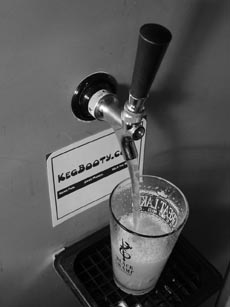More Advice
On Building A Kegerator ~
If
you've got a knack for building and can follow a basic
design blueprint, it's not too difficult to build
a kegerator. For the uninitiated, a kegerator,
as its name suggests, is the product of a beer keg
and a garden variety refrigerator used specifically
to administer cold, frothy, alcoholic beverages (though
any carbonated drink will do). Most kegerators are
"devoted" refrigerators; they're typically
not used as day-in and day-out appliances.

To build a
kegerator, you'll need a few basic pieces of equipment
beyond the keg itself. The most important of these is
a CO2 tank from which the gas is dispensed to be mixed
with the beer. An average CO2 tank runs five gallons
and may be filled at a local party store or liquor shop
for about five or 10 dollars. To go with this tank,
you'll also require a regulator with a pressure gauge
to help keep an eye on your kegerator's PSI level. If
it's too high or too low, you and your guests will taste
the difference.
- Once you
have your CO2, your keg, and your regulator and gauges
in place, you'll also need a tap, which usually comes
along with an air line, and a faucet as well. Many
people confuse the tap and faucet, but the tap is
the instrument that fits directly on top of the keg
while the faucet is the site where the beer comes
out. Finally, there are a host of fittings that go
with your CO2 tank that are
used to seal their contents and adjust their flow.
Before
you build a kegerator, you should decide on the basic
layout of your system. Some beer kegerators enclose
both their kegs and CO2 tanks inside the housing unit.
In other instances, the CO2 may be kept separate,
provided the air line still reaches and can be properly
affixed. There are also those beer fans who enjoy
showing off their handiwork, while others build their
systems to conceal everything but the faucet.
|
|



